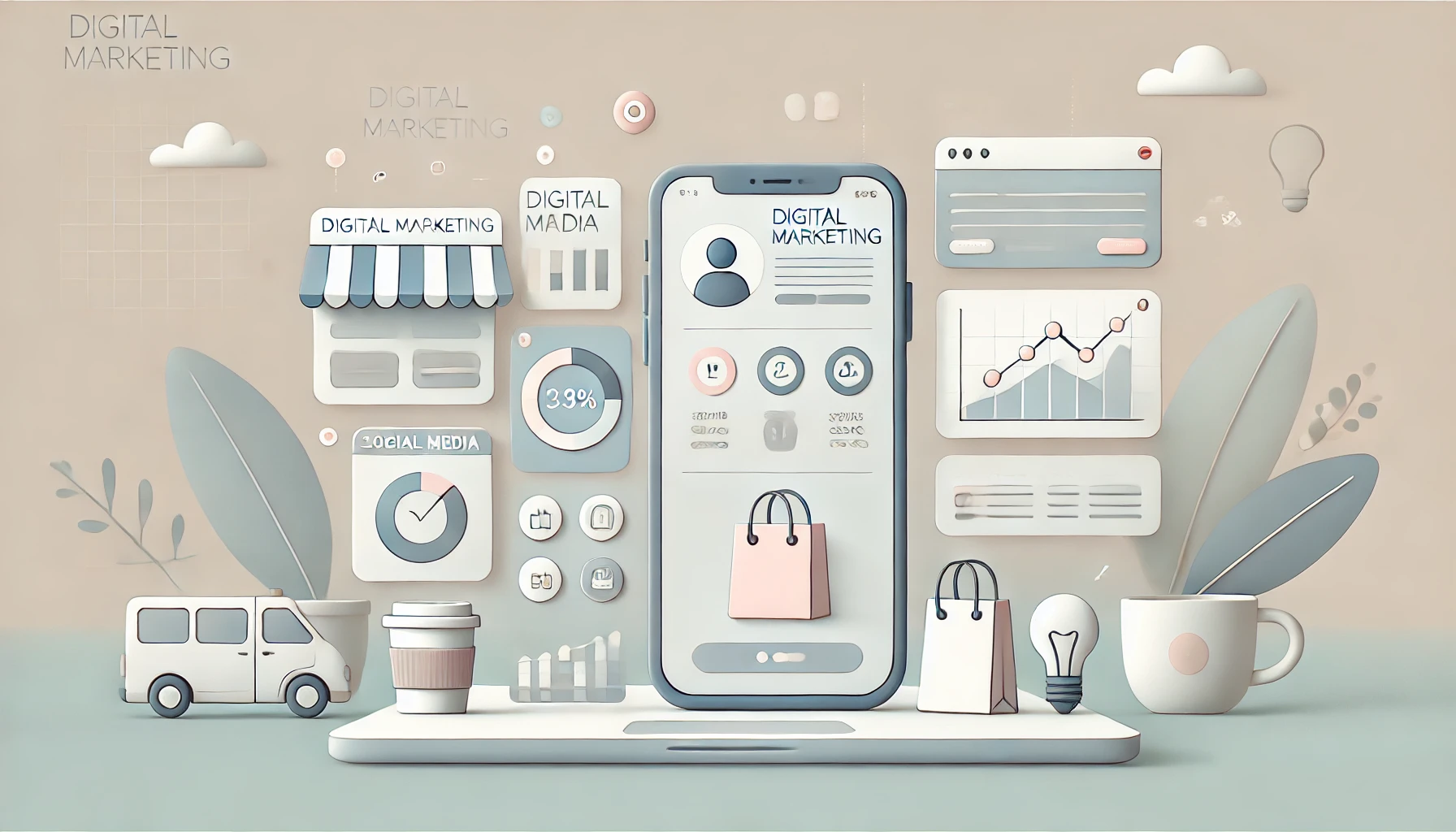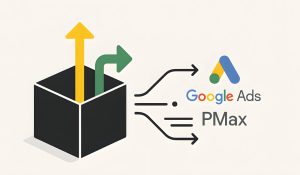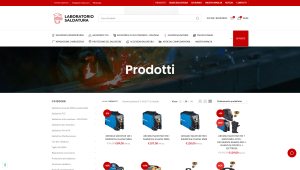Why Bother with Digital Marketing? A Small Business Owner’s Perspective
Look, I get it. You’re running a small business, juggling a million tasks, and now everyone’s telling you that you need to “do digital marketing.” As if you didn’t have enough on your plate already.
I was in your shoes not too long ago. My family-run bookstore was struggling to compete with the big online retailers. We had a website, sure, but it was about as effective as a signpost in a ghost town.
Then COVID hit, and suddenly, being online wasn’t just important—it was our lifeline.
This isn’t going to be another preachy article full of buzzwords and vague promises. Instead, I’m going to share what I’ve learned the hard way:
- How we used a simple email newsletter to keep our most loyal customers coming back
- The $50 Facebook ad campaign that brought in more business than our $500 local newspaper ad
- Why our badly-shot TikTok videos outperformed our professional Instagram posts
- The free Google My Business listing that’s now our biggest source of new customers
Digital marketing isn’t about doing everything. It’s about finding the few things that work for your specific business and doubling down on them.
If you’re skeptical, good. You should be. But if you’re curious about how digital marketing might actually work for a business like yours, keep reading. No fluff, no jargon—just real talk from one small business owner to another.
The Real Benefits of Digital Marketing (That Actually Matter to Small Businesses)
When I first dipped my toes into digital marketing, I was overwhelmed by all the supposed benefits. But after a year of trial and error, here are the advantages that actually made a difference to our bottom line:
1. Stretching Every Dollar
Let’s be honest, as small business owners, we’re always watching our spending. Here’s how digital marketing helped us do more with less:
- Our $200/month Google Ads budget consistently outperformed our $1000/month local radio spot. We could track every click and sale, allowing us to refine our ads for better results.
- We cut our printing costs by 70% by moving most of our promotional materials online. Bonus: no more boxes of outdated flyers cluttering up the stockroom.
2. Finding Our People
Mass marketing never worked for us – we needed to find the readers who’d love our curated book selection. Digital marketing made this possible:
- We used Facebook’s interest targeting to promote our sci-fi section to local sci-fi enthusiasts. Result: a 40% increase in genre sales and a new monthly book club.
- Our email list segmentation meant we could notify history buffs about new arrivals without spamming our fiction readers. Open rates jumped from 15% to 32%.
3. Competing with the Big Guys
As a small bookstore, we’re up against giants like Amazon. Digital leveled the playing field:
- Our Instagram ‘Shelf Tours’ and staff picks gave us a personal touch the algorithms couldn’t match. We’ve had customers drive from two towns over because they connected with our content.
- Local SEO put us on the map – literally. We now show up in “bookstores near me” searches, bringing in tourists and new locals who didn’t know we existed.
4. Building Real Relationships
Digital isn’t just about sales – it’s about community:
- Our Facebook group for local book lovers has become a hub for literary events in town. We’re now seen as community leaders, not just another shop.
- Customer service via Facebook Messenger has saved us countless hours on the phone and helped us resolve issues faster. Happy customers tell their friends.
5. Learning and Adapting Quickly
The best part about digital? You can change course quickly:
- When our first email campaign flopped, we A/B tested different subject lines the next week. Our open rates doubled.
- Website analytics showed us that visitors spent the most time on our staff recommendation pages. We quickly made those more prominent, leading to a 25% increase in online sales.
Remember, these benefits didn’t happen overnight. It took time, patience, and a willingness to learn from our mistakes. But for us, the payoff has been worth every late night spent figuring out MailChimp or scratching our heads over Google Analytics.
In the next section, I’ll break down the specific strategies we used to achieve these results, and how you can adapt them for your business, whether you’re selling books, baubles, or accounting services.
Digital Marketing Strategies That Actually Work for Small Businesses
Look, I’m not going to give you a marketing textbook here. These are the strategies that worked for us, a small bookstore with limited time and budget. Take what resonates with your business and leave the rest.
1. Local SEO: Be Visible When It Matters
This was our game-changer. It’s not sexy, but it works.
- Claim your Google My Business listing. It’s free and it puts you on Google Maps. We saw a 30% increase in foot traffic just from this.
- Use location-based keywords on your website. We added “bookstore in [Our City]” to our homepage title and meta description. Boom – top 3 in local search results.
- Encourage (don’t beg for) reviews. We started asking happy customers if they’d mind leaving a Google review. Our rating went from 3.8 to 4.6 stars in 6 months.
Time investment: About 2 hours to set up, then 15 minutes a week to manage.
2. Content Marketing: Show Your Expertise
This isn’t about blogging every day. It’s about sharing what you know.
- We started a “Book of the Week” feature. Just a photo, a short review, and why we loved it. Shared on our website and social media.
- Created a simple “Summer Reading Guide” PDF. Offered it for free in exchange for email signups. Our mailing list grew by 200 subscribers in a month.
- Recorded casual “Shelf Talk” videos where staff discuss new arrivals or favorite reads. These perform better than our polished promo videos and take less time to make.
Time investment: 2-3 hours a week, mostly done during quiet periods in the store.
3. Email Marketing: Your Direct Line to Customers
Don’t sleep on email. It’s old school, but it works.
- We use MailChimp (free up to 2,000 subscribers). Started with a monthly newsletter, now we’re up to weekly without annoying folks.
- Segmented our list by genre preference. Fantasy lovers don’t get bombarded with cookbook promotions.
- Always include a clear call-to-action. “Check out our Fantasy section” works better than “Hope to see you soon!”
Time investment: 2 hours to set up, then about 1 hour per email campaign.
4. Social Media: Be Where Your Customers Are
Don’t try to be everywhere. Pick one or two platforms and do them well.
- Facebook works for us because our demographic skews 35+. We post daily: a mix of book recommendations, store updates, and community news.
- Instagram is great for younger readers. We do “Bookstagram” style photos and behind-the-scenes Stories.
- We tried Twitter but it didn’t click with our audience. We dropped it after 3 months. No shame in that.
Time investment: 30 minutes a day, mostly done in small pockets of downtime.
5. Paid Advertising: Start Small, Scale What Works
You don’t need a big budget to start.
- We began with $5/day on Facebook Ads, targeting local users interested in reading. Focused on promoting events and new arrivals.
- Google Ads keyword targeting brought in customers searching for specific books. Started with $150/month, now up to $500 because of consistent ROI.
- Always use landing pages for paid traffic. We saw conversion rates jump from 2% to 7% when we sent ads to custom pages instead of our homepage.
Time investment: 2 hours to set up, then 1 hour a week to monitor and adjust.
Remember, you don’t have to do all of these at once. We started with Local SEO and email, then gradually added the others as we got more comfortable. The key is to start small, measure results, and double down on what works for your specific business.
Next up, I’ll share how we track all this without getting lost in a sea of data. Spoiler: It’s simpler than you might think.
Keeping Score: How to Track Your Digital Marketing (Without Losing Your Mind)
When I first started with digital marketing, I thought I needed a degree in data science to understand if it was working. Turns out, that’s not true. Here’s how we keep track of our efforts without drowning in data:
1. Focus on What Matters
Don’t try to measure everything. We track these key metrics:
- Website traffic: Are more people visiting our site?
- Sales: Are we selling more books (both online and in-store)?
- Email list growth: Is our subscriber count going up?
- Social media engagement: Are people interacting with our posts?
- Foot traffic: Are more people coming into the store?
That’s it. Everything else is just noise for now.
2. Use (Free) Tools That Make Sense
You don’t need fancy software. Here’s what we use:
- Google Analytics: Free and powerful. We mainly use it to track website visitors and where they come from.
- Facebook Insights: Built into our Facebook page. Shows reach and engagement of our posts.
- MailChimp Reports: Comes with our email service. We check open rates and click-throughs.
- Good Old Spreadsheets: We track weekly sales and foot traffic in a simple Google Sheet.
Time investment: About 30 minutes every Monday morning to update our numbers.
3. Set Realistic Benchmarks
Don’t compare yourself to Amazon. Here’s how we set goals:
- First 3 months: Just focus on consistently executing your strategies. Use this time to gather baseline data.
- Months 3-6: Aim for a 10% improvement in your key metrics.
- Months 6-12: Target 25-50% growth in areas where you’re seeing traction.
Remember, slow and steady growth is more sustainable than overnight success.
4. Learn to Spot Trends
You don’t need to be a data analyst. Just look for patterns:
- We noticed our email open rates spike when we send on Tuesday mornings. We now schedule most emails for Tuesdays.
- Our “Staff Picks” posts on Instagram consistently get 2x more engagement than other posts. We now do more of these.
- Website traffic from Google jumped 40% the month after we optimized for local SEO. Clearly, that was worth the effort.
5. Connect Online Metrics to Real-World Results
Digital numbers are great, but tie them to your business goals:
- We ask new customers how they heard about us. We’ve seen a 50% increase in people saying “Found you on Google” since starting our SEO efforts.
- We track sales of books featured in our email newsletter. These titles sell 3x more than non-featured books in the week after an email goes out.
- We compare our Facebook Event RSVPs to actual event attendance. About 30% of RSVPs show up, so we plan accordingly.
6. Don’t Obsess Over Perfection
Your tracking system doesn’t need to be perfect:
- We started by just writing down our weekly website visitors and sales in a notebook. It was better than nothing.
- As we got more comfortable, we gradually added more metrics and refined our tracking.
- We still miss a week of data collection now and then. We don’t sweat it – we just pick up where we left off.
The goal isn’t to become a master statistician. It’s to understand if your efforts are paying off and where to focus next.
In the next section, I’ll share how we use this data to make decisions and continuously improve our digital marketing. Spoiler: It’s not about fancy algorithms – it’s about common sense and knowing your customers.
Making Sense of the Numbers: Using Data to Improve Your Marketing (Without Getting a Headache)
Alright, you’ve got some data. Now what? Here’s how we use our numbers to make our marketing better, without overthinking it:
1. Use the “So What?” Test
For every piece of data, ask yourself, “So what?” If you can’t answer that, the data probably isn’t useful. Here’s how we do it:
- Website traffic up 20%? So what? Are sales up too? If not, maybe we’re attracting the wrong visitors.
- Email open rates down? So what? If click-throughs and sales are steady, maybe our subject lines just need work.
- Instagram followers increased? So what? If engagement is low, we might just be attracting bots.
2. Look for Easy Wins
Start with the low-hanging fruit. What small changes can make a big difference?
- We noticed our “New Arrivals” email had a 40% higher open rate than others. Now we use similar subject lines for other emails.
- Posts mentioning local events got 3x more shares. We now include a “Local Happenings” section in our weekly content calendar.
- Our Google Ad mentioning “Free Shipping” had a 25% higher click-through rate. We added this to all our ad copy.
3. Kill What’s Not Working
Be ruthless. If something’s not delivering, cut it:
- Our Twitter account had 2,000 followers but drove only 3 website visits in a month. We shut it down and focused on Instagram instead.
- Tuesday night author readings had low attendance for three months straight. We moved them to Saturday afternoons and saw attendance triple.
- Our Google Ads for general terms like “books” were expensive and ineffective. We switched to targeting specific genres and local terms, cutting our cost per click in half.
4. Double Down on What Works
When you find something that works, milk it:
- Our “Staff Picks” shelf consistently outsells other displays by 50%. We now rotate staff picks weekly and feature them prominently on our website and social media.
- Email subscribers spend 3x more than non-subscribers. We added email sign-up prompts at checkout and on our homepage, doubling our list growth rate.
- Our Facebook “Book of the Day” post outperforms other content by 4x. We now do it daily instead of weekly.
5. Test One Thing at a Time
Don’t change everything at once. Here’s our simple testing process:
- Choose one thing to improve (e.g., email open rates)
- Make one change (e.g., test two different subject line styles)
- Run the test for at least two weeks
- Check the results
- Keep the winner, then test something else
Recent test: We tried emojis in email subject lines. Result? 15% higher open rates. Now we use them judiciously.
6. Listen to Your Customers (They’re Smarter Than the Data)
Numbers don’t tell the whole story. We also:
- Keep a “Customer Comments” notebook at the register. Staff jot down interesting feedback or requests.
- Do a quick survey every quarter using Google Forms. We ask what customers love and what we could do better.
- Pay attention to common customer service issues. If we get three similar complaints, we know it’s time to make a change.
Example: Multiple customers mentioned wanting book recommendations for kids. We started a “Young Readers” newsletter, which now has our highest engagement rate.
7. Don’t Forget the Real World
Digital is great, but remember the human touch:
- We noticed our most engaged social media followers weren’t always our best customers. So we started a “Reader of the Month” feature, highlighting loyal customers in-store and online. It boosted both in-store visits and social engagement.
- Our data showed a lot of website visitors weren’t converting. We started asking in-store customers if they’d visited our site. Turns out, many found our online inventory system confusing. We simplified it and saw online sales increase by 30%.
Remember, the goal of all this data stuff isn’t to become a marketing guru. It’s to understand your customers better and serve them more effectively. Keep it simple, focus on what matters to your business, and always prioritize your customers’ needs over fancy marketing tactics.
Next up, I’ll share some final thoughts on keeping your sanity while navigating the world of digital marketing as a small business owner. Spoiler: It involves knowing when to step away from the computer.
Keeping Your Sanity: Final Thoughts on Digital Marketing for Small Business Owners
If you’ve made it this far, congratulations! You’re already ahead of most small business owners who are still trying to figure out if they need a TikTok account. (Spoiler: You probably don’t, unless you’re selling to teens or running a dance studio.)
Let’s wrap this up with some final thoughts on how to approach digital marketing without losing your mind—or your passion for your business.
Remember Why You Started
- Your business isn’t about Facebook likes or email open rates. It’s about your products, your service, and your customers.
- Use digital marketing to enhance what you’re already doing, not to replace it.
- Our most successful campaign? A simple email reminding customers why we started our bookstore. It resonated more than any clever marketing tactic.
Start Small, Stay Consistent
- You don’t need to do everything at once. We started with just a Facebook page and an email list.
- Consistency trumps perfection. Our weekly newsletter isn’t award-winning, but it goes out every Tuesday, rain or shine.
- Set realistic goals. Our first year’s digital marketing goal was simply “Don’t lose money on ads.” We achieved it, and then some.
Know When to Unplug
- Digital marketing can be a 24/7 job if you let it. Don’t.
- We have a strict “no social media after 7 PM” rule. The world won’t end if we don’t respond to a Facebook comment immediately.
- Take regular ‘digital detoxes’. We do a week-long “analog only” challenge every quarter. It reminds us why we love books in the first place.
Embrace the Learning Curve
- None of us were born knowing how to run Facebook ads. It’s okay to mess up.
- We’ve had our share of blunders (like the time we accidentally sent a “Happy Birthday” email to our entire list). Learn, laugh, and move on.
- Keep learning, but don’t feel pressured to know everything. We budget for one online course or workshop per year to keep our skills fresh.
Don’t Neglect Real-World Marketing
- Digital is powerful, but it’s not everything. Our sidewalk chalkboard still brings in curious passersby.
- Some of our best marketing ideas come from chatting with customers in the store. No algorithm can replace that.
- We still do local author events, book clubs, and community partnerships. They don’t always show up in our digital metrics, but they’re crucial to our success.
Measure What Matters to You
- Ignore vanity metrics. We’d rather have 100 engaged Instagram followers than 10,000 silent ones.
- Focus on metrics that tie directly to your business goals. For us, it’s books sold and customer retention, not likes and shares.
- Don’t compare your metrics to big corporations or even other small businesses. Your journey is unique.
Keep the Human Touch
- Behind every click, open, and purchase is a real person. Never forget that.
- We use digital tools to enhance personal connections, not replace them. Our email segmentation exists so we can give personalized recommendations, just like we do in-store.
- The best marketing often happens when you’re not “doing marketing.” Exceptional customer service, genuine passion for your products, and word-of-mouth referrals are still golden.
Final Word: It’s a Tool, Not a Takeover
Digital marketing is a powerful tool, but it’s just that—a tool. Use it wisely, but don’t let it use you. Your time, creativity, and passion for your business are your most valuable assets. Invest them wisely.
Remember, at the end of the day, it’s not about being a digital marketing guru. It’s about using these tools to share your business with the world, connect with your customers, and yes, sell more of whatever it is you’re selling.
Need a Hand? We’ve Got You Covered
Look, I get it. This is a lot to take in, and you might be thinking, “This sounds great, but I barely have time to run my business, let alone become a digital marketing expert.”
That’s exactly why I shared my story with Digital Connect. They helped us navigate this digital landscape when we felt overwhelmed, and now we’re partnering with them to help other small businesses like yours.
If you’re feeling excited about the possibilities of digital marketing but daunted by the execution, why not have a chat with the team at Digital Connect? They offer:
- Free 30-minute consultations to assess your specific needs
- Customized strategies that align with your business goals and budget
- Hands-on training if you want to learn the ropes yourself
- Full-service management if you’d rather focus on running your business
No pressure, no hard sell. Just practical help from folks who understand the challenges of small business.
You can reach out through the contact form or give them a call. Mention this article, and they’ll throw in a free local SEO audit for your business.
Whether you decide to go it alone or get some help, the important thing is to start. Your customers are out there in the digital world—it’s time to meet them where they are.
Now, step away from the computer and go talk to a customer. That’s where the real magic happens. And if you need a digital wingman along the way, you know where to find us.







